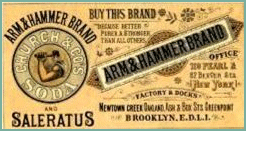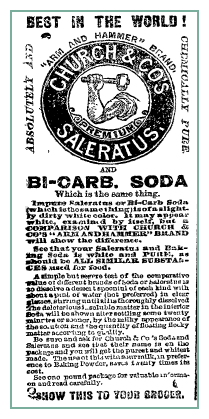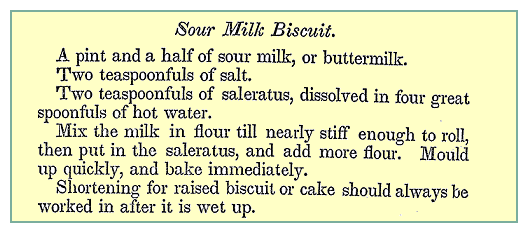saleratus / soda

soda
The protoxide of the metal sodium, formerly called, though not appropriately, mineral alkali. — Webster, 1882saleratus
A bicarbonate of potash, not always pure, containing a greater quantity of carbonic acid than pearlash. It is much used in cookery. — Webster, 1882
 Simply put, saleratus is baking soda. The term saleratus was originally applied to bicarbonate of potash, and previous to the introduction of baking powders (a combination of cream of tartar and baking soda), was in common use in the pioneer kitchen. Its greater cost led to the substitution for saleratus of the much cheaper compound bicarbonate of soda, and eventually, none of the commercial saleratus sold by grocers contained the potash salt.
Simply put, saleratus is baking soda. The term saleratus was originally applied to bicarbonate of potash, and previous to the introduction of baking powders (a combination of cream of tartar and baking soda), was in common use in the pioneer kitchen. Its greater cost led to the substitution for saleratus of the much cheaper compound bicarbonate of soda, and eventually, none of the commercial saleratus sold by grocers contained the potash salt.
Saleratus was made by pouring water through wood ashes, producing lye. The lye was then evaporated by boiling, leaving a residue called black salt. The salt was purified by fire, resulting in potash. Further baking in a kiln caused all the carbon impurities to be burned off, changing the potash into pearlash, which was fermented, producing carbonic acid that was then absorbed by the pearlash. The rendered solid was heavier, whiter, and drier than the pearlash, and had finally become saleratus.
 Soda and Saleratus.
Soda and Saleratus.
Soda and saleratus are different common names for the same article, which is in fact the bicarbonate of sodium. Although the term saleratus, or sal aëratus–aërating salt–was originally applied to a super-carbonated potash, it has been adopted for bicarbonated soda, by some dealers in the latter article. The potash saleratus, introduced before soda became the cheaper alkali of the world, was a granular mixture of bicarbonate of potassium with a smaller part of normal carbonate of potassium. The soda saleratus is bicarbonate of sodium, liable to contain normal carbonate, either from deficient charging with carbonic acid gas in the manufacture or from loss of this gas through the action of heat in concentrating and drying. Potash saleratus has not been in use in this generation as a bread-aërating salt, and does not enter into any of the baking powders. The super-carbonate of ammonium, and carbonate of calcium, have each been applied in certain special methods for vesiculating bread, but the bicarbonate of potassium is too dear a salt to be offered when the dealers have their option of the cheap sodium bicarbonate. It must be granted that potash compounds are apt to be deficient in the food of animals, as well as in the food of plants, but it is not desirable to supply potash in a bread-aërating salt, because the bicarbonate of potassium is too strongly alkaline, and too nearly caustic in effect, to be trusted in common use with the danger of incomplete neutralization. It is fortunate that the milder alkali has been the cheaper one, by favor of chemical inventions giving production of alkali from common salt, and dating back to the second decade of this century. The sodium bicarbonate which is put upon the market in packages, with printed wrappers, is in part presented under the name of saleratus; while that sold in bulk goes with the name of baking soda, or bicarbonate of soda. — Victor C. Vaughan, M.D., editor. The Physician and Surgeon, Volume IV. Ann Arbor, Michigan: John William Keating, Publisher, 1882, pages 354-355.
Using Saleratus or Baking Soda.
In cooking, saleratus or baking soda, and baking powder, are classed as leavening agents, the same as yeast. They are chemical compounds, however, and should be considered as such. Even though baking powder contains baking soda, you can’t use the two interchangeably due to the different ways in which they react. Baking soda is a crystalline alkali which produces gas bubbles – mainly carbon dioxide – when it comes in contact with acids. For this reason, baking soda is used in recipes which contain some sort of acid, such as honey, molasses,buttermilk, or fruit juice. The chemical reaction takes place immediately when the soda and acid are mixed, so mixtures must be baked immediately.
In The Long Winter (Chapter 22, “Cold and Dark”), Ma adds salt and saleratus to her sour dough starter, then adds the wheat flour ground in the coffee mill. She says she is making “bread” for dinner, which will be ready by the time Pa finishes doing the chores. What Ma was making was more like biscuits, with the acidic starter and saleratus causing the flour mixture to rise.
 At the end of The Long Winter, when Ma once again can get supplies from the stores in town, she says, “Now that I have cream of tartar and plenty of saleratus, I shall make a cake.” (See Chapter 33, “Christmas in May”) It is interesting to note that in the existing Hard Winter manuscript, both instances where saleratus appears in the published version, soda is used in the manuscript. Saleratus does not appear at all in the handwritten Pioneer Girl manuscript.
At the end of The Long Winter, when Ma once again can get supplies from the stores in town, she says, “Now that I have cream of tartar and plenty of saleratus, I shall make a cake.” (See Chapter 33, “Christmas in May”) It is interesting to note that in the existing Hard Winter manuscript, both instances where saleratus appears in the published version, soda is used in the manuscript. Saleratus does not appear at all in the handwritten Pioneer Girl manuscript.
In The Long Winter, Ma uses sour dough once there is no longer any milk to allow to sour for use in biscuits. Laura explains this substitution to Mrs. Boast in By the Shores of Silver Lake (Chapter 21, “Merry Christmas”).
The biscuit recipe at left makes what the Ingalls family knew as light biscuits, when made using white flour.
— Recipe from Catherine Esther Beecher, Miss Beecher’s Domestic Receipt Book (New York: Harper, 1850), 93.
Soda Crackers.
Rub two ounces of butter into a quart of flour. Put in a tea-spoonful of saleratus, and half a teaspoonful of salt. Make it up with milk enough to have a stiff dough. Beat it for half an hour, or till it is quite smooth; roll it out thin, and cut it into small cakes; stick them with a fork, and bake them in a moderate oven. — Angelina Maria Collins. The Great Western Cook Book (New York: A.S. Barnes & Company, 1857), 56-57.
Adding baking soda to water when cooking beans.
In The Long Winter (Chapter 4, “October Blizzard”), Caroline Ingalls adds a spoonful of soda to a kettle of boiling beans. “The boiling beans roared, foaming up, but did not quite run over.” In this case, soda was used to soften the hard water used in cooking. This is not necessary, and may add a soapy taste to the cooked beans. Large amounts of baking soda (more than 1/8 teaspoon per cupful of water) may destroy the thiamine (Vitamin B1) in the beans.

soda (SSL 21; TLW 4; PG)
soda crackers (SSL 14; TLW 33)
soda-water (TLW 4)
saleratus (TLW 22, 33), see also cream of tartar

